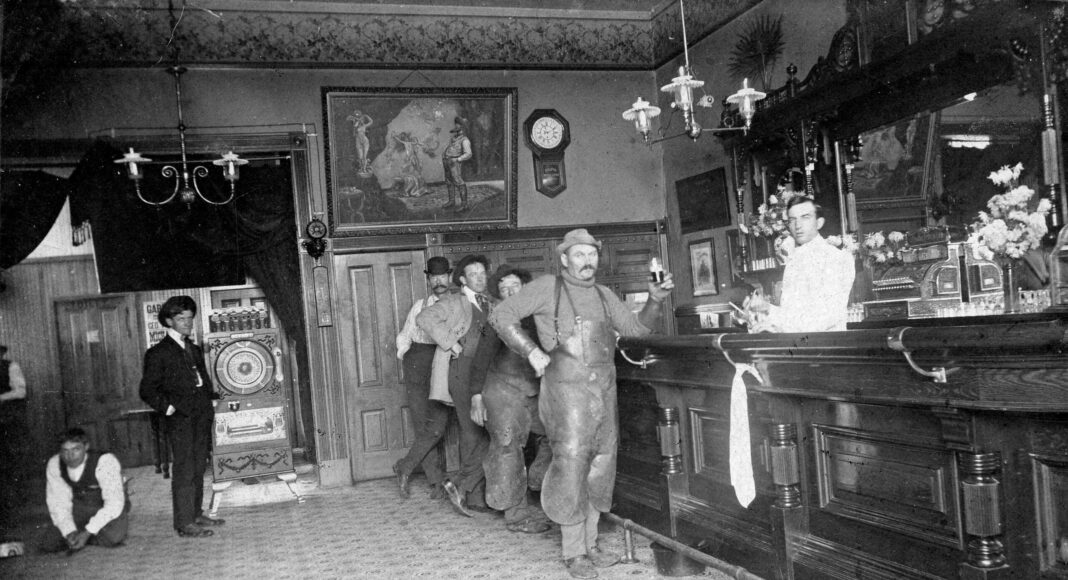At the turn of the century, San Jose claimed many bars and clubs.
In particular, the Palace Saloon on The Alameda near Cahill, just off the railroad tracks, was a notorious watering hole. Before Google, before the Sharks, before the Downtown West Community Stabilization & Opportunity Pathways Fund, we had the Palace Saloon with a brothel upstairs, right where the entrance to Diridon Station now sits. Rod Diridon and the building named after him were not yet to be. The tiny station back then was simply known as “the narrow gauge depot.”
The late San Jose historian Leonard McKay donated this 1902 photo to the History San Jose archives and thus supplied the pertinent info. The bartender is Frank Welch. At the bar, we have Otto Eventrout, a teamster for Old Joe’s beer, along with his helper, plus a sign painter named Carl Fisher and a cyclist named P. G. Bailey. The dude on the floor appears to be working on the linoleum. Old city directories list a Mr. J. Woods as the proprietor, although he is not in the photograph.
Even before 1902, though, several newspaper tidbits mention the Palace Saloon in the late 19th century. Robberies took place. Someone stole a horse and buggy. A few drunks tossed bricks through the window. The usual Wild West shenanigans for a bar at the railroad depot. In fact, if you think about it, maybe the Caravan opening up inside the Greyhound Station 60 years later wasn’t that crazy of an idea. Maybe the Palace Saloon set the precedent.
One lurid yarn stands out above the rest. An amazing 2,500-word Evening News story on Nov. 11, 1892, led with the following paragraph:
“One of the darkest and saddest murder mysteries ever known in the history of San Jose, or of any other community even in the Wild West, was enacted at an early hour this morning on West Julian street. The dead body of Henry Planz, an estimable young man and recently installed manager of the Fredericksburg Brewery, was found hanging by the neck to a pepper tree.”
According to the Evening News, the foliage in question was the first pepper tree east of the Julian Street bridge that went over the Guadalupe River—in today’s world, a stretch of old Julian that doesn’t exist anymore. Investigations determined that Planz was walking toward his home on Stockton Avenue when a few thugs jumped him and hit him with sandbags, inadvertently killing the young man, after which they strung him up from the tree to make it look like suicide. Planz was only 25.
The hanging corpse was discovered by John Sullivan, a switch engine fireman for Southern Pacific, as he walked to his home at 284 San Augustine St., which is now the westernmost portion of St. John. Sullivan had taken a shortcut, sneaking through a hole in a fence on the south side of Julian. As soon as he stepped through the fence to the sidewalk, he saw a man’s hat laying on the ground. He was about to pick it up when his head struck two human feet, the dead body, hanging from the tree.
The Evening News story even pieced together Planz’s movements the night beforehand. From the Palace Saloon, Planz went down the street and entered the Oberon Saloon at 75 W. Santa Clara St., where he played a few card games with proprietor George Keffel. He then ate a sandwich. The Oberon closed at midnight, so Planz then started toward First Street and went into the Overland Restaurant with someone named Hugh Invernal. Then both men left and meandered up to St. John, after which Planz continued solo down Julian, as it was the fastest route to his place on Stockton.
The Palace Saloon bore no responsibility for the crime, but the story is a sad one because the perpetrators were never brought to justice. The pepper tree was later chopped down, so don’t go looking for it.
According to Leonard McKay, the upper story of the Palace Saloon building, the former brothel, was later relocated to Morse Street, where it was then remodeled and turned into a million-dollar-plus family home.
So much for the Wild West.



